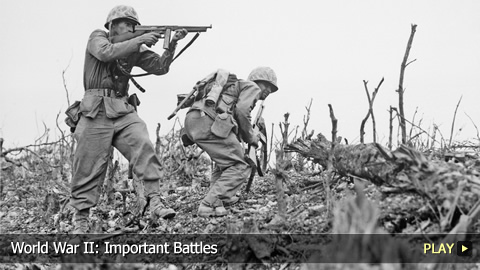World War II: Important Battles

advertisement
VOICE OVER: Rebecca Brayton
World War II was a series of the bloodiest battles in history. Unparalleled civilian casualties, new weapons and tactics, as well as a new emphasis on air warfare helped make the Second World War so deadly. The Battle of the Atlantic raged almost the entire length of the war, while the Battle of Britain proved how important air warfare was. Fights for the Soviet cities of Stalingrad and Leningrad killed countless residents. Pearl Harbor drew the United States into the conflict, and the Battle of Berlin helped bring the Nazis down. In Part 5 of our series on WWII, http://www.WatchMojo.com learns about some of the most important battles of World War II.
History of World War II: Important Battles
This war was a series of the bloodiest battles in history. Welcome to WatchMojo.com, and today we’re learning about some of the most important battles of World War II.
The Battle of the Atlantic
(3 September 1939 – 8 May 1945)This battle lasted almost the entire length of the war, but peaked between 1940 and 1943. Germany and Great Britain fought for control of the Atlantic sea routes. To block the British people from their supplies, the German Navy and Air Force attacked Allied shipping. However, these routes were protected by British and Canadian forces. In early May 1945, the Germans were defeated. But, massive casualties were felt on both sides.
The Battle of Britain
(10 July – 31 October 1940)This was the first major battle to be fought solely by air forces. Beginning in July 1940, the German Air Force began air raids over Britain. They eventually resorted to terror campaigns and the destruction of important locations. Civilian losses were high. However, by the end of October, the Nazis failed. This collapse prevented a full-scale invasion of Britain, and marked the first time Hitler’s forces lost. It also proved the importance of the air in terms of military superiority.
The Siege of Leningrad
(8 September 1941 – 27 January 1944)Between September 1941 and January 1944, Nazi tanks encroached on the strategically-important city of Leningrad. Civilians helped build fortifications to keep the Nazis out and to support the Red Army forces. This helped neutralize the German advance. But the win came at a huge cost: over one million civilians died during the siege, not to mention the million Soviet soldiers who were killed.
Pearl Harbor
(7 December 1941)The December 7th, 1941 surprise attack by Japanese forces on Pearl Harbor in Hawaii drew the Americans into World War II. The Japanese acted to ensure they would be able to continue their expansion through Southeast Asia unimpeded by the U.S. Two waves of Japanese forces battered the unprepared Americans on their own shores, and this resulted in well over two thousand American deaths and a great deal of equipment lost.
The Battle of Stalingrad
(23 August 1942 – 2 February 1943)In this battle, the Germans fought the Soviets for control of the tactically-valuable city of Stalingrad. The significant loss of German fighters and the stall of the German advance made this a turning point in the war. Fighting began August 23rd, 1942, and involved extensive bombing from the air as well as machine gun fire in the streets. The Nazis finally capitulated in February 1943, but not before about 40 thousand civilians were killed.
The Invasion of Normandy
(6 June 1944 – mid-July 1944)This is one of the most celebrated and bloodiest battles in the war. Allied forces from Britain, the U.S. and Canada landed on Normandy beaches on June 6th, 1944 to free Northern France from the Nazis. A brutal battle ensued. Finally, by the end of August the Allies had freed most of the area from Nazi rule, but casualties were high on both sides. June 6th is now known as D-Day, and is celebrated each year.
The Battle of the Bulge
(16 December 1944 – 28 January 1945)The Allies invaded the Belgian forest during the winter of 1944. Bad weather and overconfidence almost caused them to fail. However by Christmas they regained their strength and quickly forced the Germans to withdraw. According to some, the Battle of the Bulge is where Americans suffered their worst losses, with 19 thousand soldiers killed.
The Battle of Okinawa
(1 April – 21 June 1945)The Allies wanted control of Okinawa for strategic reasons. So, the Americans invaded in March 1945, supported by troops in the air and water. The Japanese retaliated with kamikaze attacks. This vicious fighting resulted in the most deaths in the Pacific Theater during the war, and made it one of the largest air-sea-land battles in history. Eventually, the United States won after two months of brutal fighting.
The Battle of Berlin
(16 April 1945 – 2 May 1945)The fight for Berlin began in mid-April 1945, when the Red Army began advancing through the city. Fierce fighting followed, but by April 30th the Soviets captured the German Reichstag. That same day, Hitler and a number of his followers committed suicide, and in just a few days the battle was officially over. This meant the end of war in Europe during World War II.


KiethSomataw99
“On the top 10 list of battles, the Number One Battle of the Top 10 Battles of World War II would be the Omaha Beach landings, the most iconic part of D-Day, the Invasion of Normandy.”
 0
0
 0
0
 report
report
